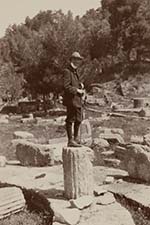Explosive Wace
…his omnivorous mind delighted in breaking new ground." F.H. Stubbings

The images in these twelve albums all share a common origin, the archaeologist Alan J. B. Wace, and medium: cellulose nitrate negatives. The photos range in date from the summer of 1902, when Wace had just graduated from Cambridge as a newly minted classicist, to 1905, by which time he had been a Student at the British School at Athens (BSA) and was poised to begin his first excavations, in Sparta in 1906 – the same year publishing with the epigraphist M.N. Tod the first ever catalogue of the Sparta Museum.
Over time, cellulose nitrate film degrades, thereby eroding the image captured on the film’s surface, releasing noxious gases, and ultimately, it can even self-combust. To safeguard the remaining images, and the integrity of the wider archival collections and entire Faculty Library, the negatives were photographed in 2022 and then removed from the archives. Hence, the images collectively can seem something of a miscellany, united not by archaeological theme but by chemistry.
One roll of film, dating to 1902-1903, features images ranging from classical sculpture in German museums to candid snaps of family in Cambridge, including Tibby the cat - in a double-exposed image - whose ghostly glare sizzles us across the span of a hundred and twenty years [ GBR/3437/AJBW/3/50/76 ]. Wace himself separated the prints from this roll of film into two distinct albums, one for art history Book B , the other dedicated to domesticity Book A . The necessity of following the original order of the physical frames of film, in order to rescue their images methodically, reveals Wace’s actual itinerary and the eclectic mix of experience for an Edwardian academic, whose public and private personae were usually kept strictly apart.
During the four years captured here in these albums, Wace, later synonymous with the Bronze Age archaeology of Mycenae, was initially considering making Hellenistic sculpture the focus of his studies, visiting Alexandria in 1902 with this purpose in mind [ GBR/3437/AJBW/3/54 and AJBW/3/61 ]. To supplement his stipend at the BSA, Wace acted as Professor Ernst Gardner’s secretary on scholarly sailing trips along the Aegean coasts of Greece and western Turkey, visiting important sites from classical antiquity. Wace was aboard the SS Pelops in 1903 and the SS Peneios in 1904 [ GBR/3437/AJBW/3/56 ]. While Wace was clearly focussed on garnering knowledge and experience of classical collections and locations, he always remained alert to the nuances of daily life encountered all around him. One example is an image of a wedding procession at Geraki (Γεράκι) in 1904, with the bride’s dowry textiles displayed spread over the donkeys’ backs [ GBR/3437/AJBW/3/59/37 ]. Another is the photo of Charalambos Stephanopoulos and his friends in the village of Dimitsana (Δημητσάνα), clad in traditional dress [ GBR/3437/AJBW/3/59/39 ] .
Painstaking digital photography by Amélie Deblauwe has saved these vanishing-into-nitrous-oxide glimpses into an era when a new century and a new archaeological career were unfurling in step with one another. We can now journey along with Wace, encountering both ancient landscapes and his Edwardian Greek and English contemporaries.
There remain several gaps in our knowledge regarding the identity of some of the images. If you recognise a landscape or a monument, perhaps even individuals, do contribute your knowledge to archives@classics.ac.uk
We are grateful to the Faculty of Classics, University of Cambridge, for assisting financially with the digitisation of these records.

